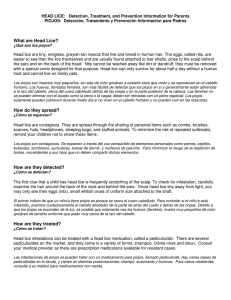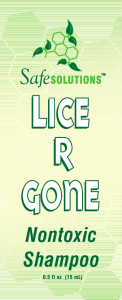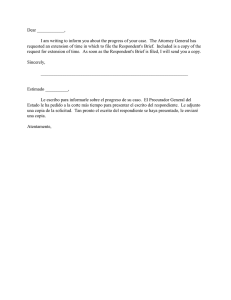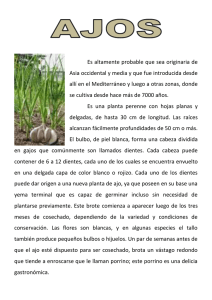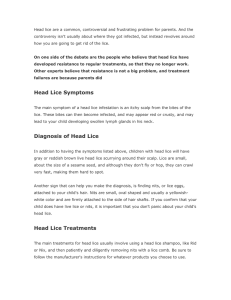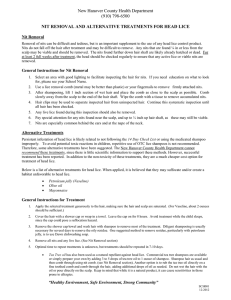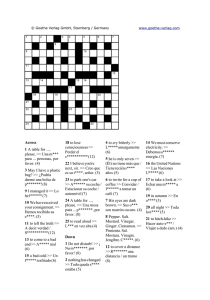how to check your child`s head for lice
Anuncio
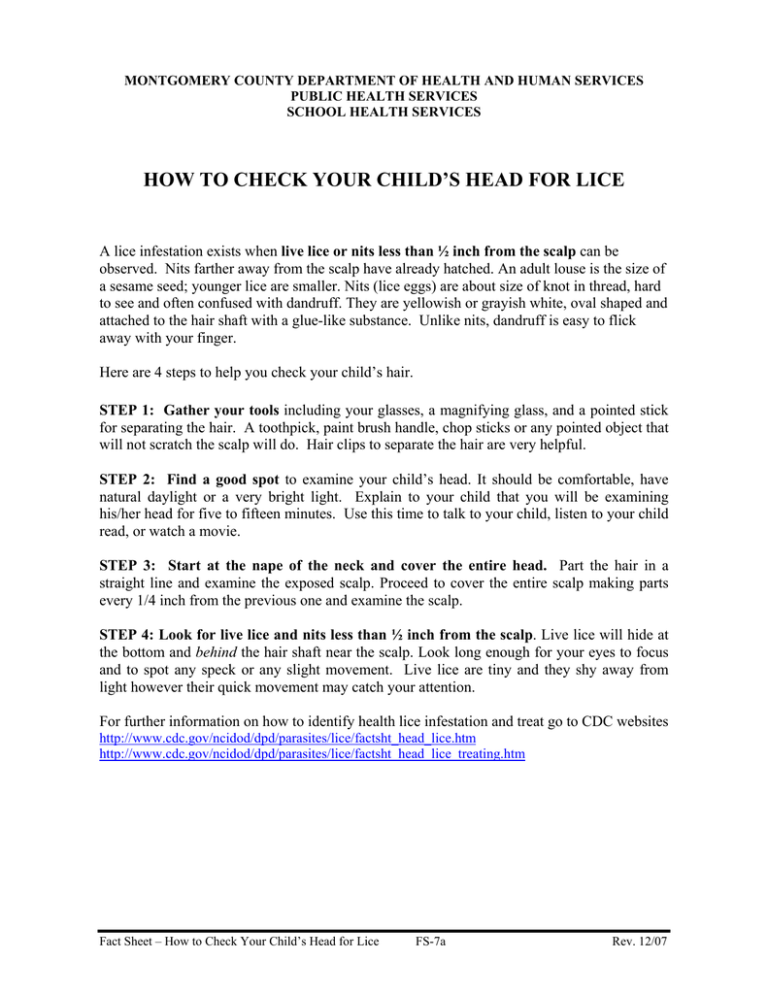
MONTGOMERY COUNTY DEPARTMENT OF HEALTH AND HUMAN SERVICES PUBLIC HEALTH SERVICES SCHOOL HEALTH SERVICES HOW TO CHECK YOUR CHILD’S HEAD FOR LICE A lice infestation exists when live lice or nits less than ½ inch from the scalp can be observed. Nits farther away from the scalp have already hatched. An adult louse is the size of a sesame seed; younger lice are smaller. Nits (lice eggs) are about size of knot in thread, hard to see and often confused with dandruff. They are yellowish or grayish white, oval shaped and attached to the hair shaft with a glue-like substance. Unlike nits, dandruff is easy to flick away with your finger. Here are 4 steps to help you check your child’s hair. STEP 1: Gather your tools including your glasses, a magnifying glass, and a pointed stick for separating the hair. A toothpick, paint brush handle, chop sticks or any pointed object that will not scratch the scalp will do. Hair clips to separate the hair are very helpful. STEP 2: Find a good spot to examine your child’s head. It should be comfortable, have natural daylight or a very bright light. Explain to your child that you will be examining his/her head for five to fifteen minutes. Use this time to talk to your child, listen to your child read, or watch a movie. STEP 3: Start at the nape of the neck and cover the entire head. Part the hair in a straight line and examine the exposed scalp. Proceed to cover the entire scalp making parts every 1/4 inch from the previous one and examine the scalp. STEP 4: Look for live lice and nits less than ½ inch from the scalp. Live lice will hide at the bottom and behind the hair shaft near the scalp. Look long enough for your eyes to focus and to spot any speck or any slight movement. Live lice are tiny and they shy away from light however their quick movement may catch your attention. For further information on how to identify health lice infestation and treat go to CDC websites http://www.cdc.gov/ncidod/dpd/parasites/lice/factsht_head_lice.htm http://www.cdc.gov/ncidod/dpd/parasites/lice/factsht_head_lice_treating.htm Fact Sheet – How to Check Your Child’s Head for Lice FS-7a Rev. 12/07 DEPARTAMENTO DE SALUD Y SERVICIOS HUMANOS DEL CONDADO DE MONTGOMERY SERVICIOS PUBLICOS DE SALUD SERVICIOS ESCOLARES COMO REVISAR LA CABEZA DE SU HIJO POR PIOJOS Una infestación de piojos existe cuando se observa que el piojo vivo o liendres están a ½ pulgada del cuero cabelludo. Liendres que están lejos del cuero cabelludo ya han incubado. Un piojo adulto es del tamaño de la semilla de ajonjolí; los piojos jóvenes son más pequeños. Las liendres (huevos del piojo) son más o menos del tamaño de un nudo del hilo, difícil de ver y a menudo se confunden con la caspa. Ellos son de color amarillento o grisáceo, de forma ovalada y adheridos al pelo con una sustancia pegajosa. A diferencia de las liendres, la caspa es fácil de sacarse cuando usa sus dedos. Aquí están los 4 pasos para chequear la cabeza de su hijo/a; PASO 1: Reúna todas sus herramientas incluyendo sus lentes, una lupa, y un palito para separar el pelo. Se puede usar palillo, el mango de una brocha de pintar, o cualquier objeto puntiagudo que no raspe el cuero cabelludo. Las presillas para separar el pelo son muy útiles. PASO 2: Encuentre un buen lugar para examinar la cabeza de su niño/a. Sería mejor si lo hace usando la luz natural o una luz artificial muy clara. Explique a su hijo/a que usted revisará la cabeza de cinco a quince minutos. Use éste tiempo para hablar con su hijo/a, escúchelo/a leer, o mire una película. PASO 3: Comience en la parte del cuello y continúe con la cabeza. Parta el pelo en una línea recta y examine el cuero cabelludo expuesto. Proceda a examinar todo el cuero cabelludo dividiendo el pelo cada ¼ de pulgada. PASO 4: Busque por piojos vivos y liendres que estén a menos de ½ pulgada del cuero cabelludo. El piojo vivo se esconderá en la parte de atrás de la nuca y cuero cabelludo. Mire meticulosamente para que sus ojos visualicen cualquier señal o movimiento por pequeño que sea. Los piojos vivos son pequeños y huyen de la luz sin embargo su movimiento rápido puede llamar su atención. Para mayor información de cómo identificar la infestación y tratamiento de piojos usted puede usar la red electrónica de CDC http://www.cdc.gov/ncidod/dpd/parasites/lice/factsht_head_lice.htm http://www.cdc.gov/ncidod/dpd/parasites/lice/factsht_head_lice_treating.htm Fact Sheet – How to Check Your Child’s Head for Lice FS-7a Rev. 12/07
